If you are starting to get the feeling that my blog has suddenly become only about hiking, you aren’t alone. However, this is partly due to coincidence and partly due to wanting to steer clear of civilization in favor of being close to nature’s cleansing air filters, plants and trees. Recently, I was feeling a little more confident to resume venturing into cities again. Since I was also getting deathly tired of the hiking post routine, I decided it was time to pay a visit to the Old Masters Museum in Brussels for the purpose of creating my next installment of one of my favorite series on this blog, Drunken Masterpieces. When last this series made an appearance, it was over one year ago. August 2019 to be exact. The post explored the Rijksmuseum and the beer glass in Dutch art.
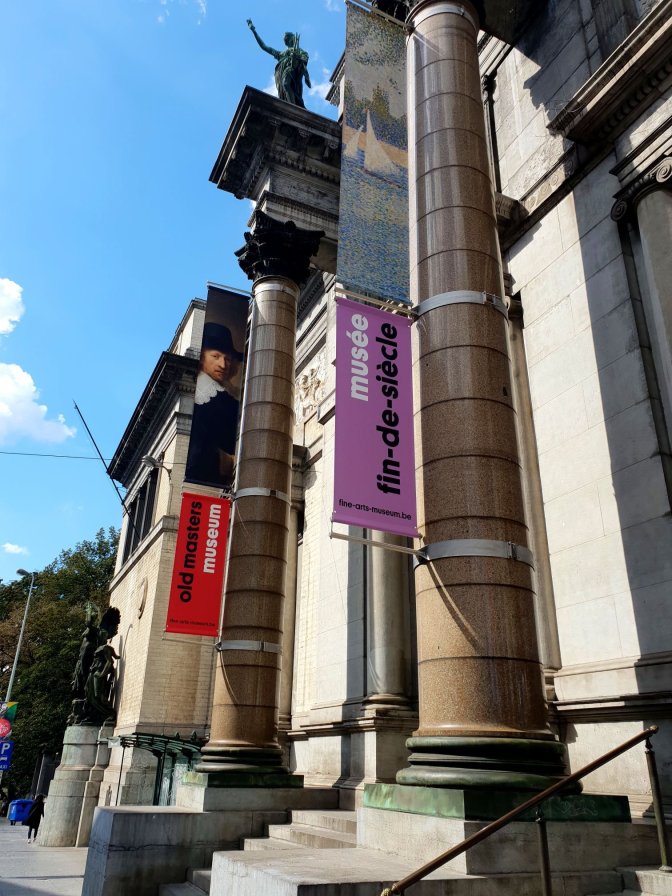
I was a bit curious how the art museum experience would be in the Age of COVID and how suffering the flowback of hot breath in a surgical mask for two hours would change my attention to detail. The Old Masters Museum has a non-linear layout. Some rooms connect only to a hallway, others connect to a hallway and to other rooms, and then there are the rooms connecting only to other rooms. In other words, it is just like every other major art museum. Only a chess grandmaster could envision the moves well in advance to achieve an efficient visit, while the rest of us become like a robotic lawnmower or vacuum cleaner moving until we reach a wall and then changing direction at a fixed angle. Eventually we find ourselves in each room, but we’ve long stopped caring about the paintings before then.
To avoid human contact, the museum has actually done a wonderful job creating a one-way path that flows thru the entire museum in a linear fashion. Not a room is missed. With the route decisions taken away from us and not having to rely on the museum map, one can completely go in cruise control and start looking for Drunken Masterpieces. Sorry, we aren’t here to talk about Rembrandts and Rubens’. But you know that by now.

I never have a theme in mind when I walk into a museum, but one of the first paintings that you see in the museum is a still life by Pieter Claesz. An object in this painting kept catching my eye in other paintings and so a theme was born. I wanted to call it a wine pitcher, but it was something more than that. A gourd-shaped body with a long spout shooting up from the bottom. Sometimes straight like a happy-to-see-you gesture and sometimes curved like a swan’s neck. Two graceful thumb levers on the top and the spout. Normally made of pewter. A vessel created to look elegant for serving wine can’t just be called a pitcher. One goes to a tavern and orders a pitcher of beer. But for wine, we use another term.
Flagon.
Bartender, a flagon of wine please…
Still Life Flagon
Pieter Claesz was a master at painting flagons. From first glance, the flagon along with a tasty-looking ham dominates his Banketje or Small Banquet. It may be small, but you can put a lot of wine in that flagon. Is there an allegory to the lid being open? The glass just behind the flagon looks like a modern whisky tumbler, a deceptively large one. It is the least elegant object in the scene and is clearly full of something. White wine? There is a Berkemeyer glass on the left of the image which would normally be the drinking glass of choice, but this appears empty. Wine is always drunk from stemmed glasses, isn’t it? These vanitas paintings are always a collection of objects in disarray. They are also almost always allegorical. It is possible the open flagon and the mysteriously hidden glass, possibly full of wine, represents hypocrisy. The person has filled a big glass with wine and hidden it but is trying to show the viewer with the open flagon and empty Berkemeyer that they don’t consume alcohol foolishly. However, I prefer to think the hidden glass is something else and the person with this chaotic spread is simply choosing to drink right from the flagon rather than bother with the Berkemeyer. The best part of the flagon is not the open lid, but what appears to be the reflection of a curtained window which is the main light source for the scene. Claesz, by the way, was born in Berchem, Belgium, a suburb of Antwerpen. He is one of many Flemish painters that migrated to the Netherlands in the early 1600’s during the religious wars. Claesz coincidentally (or not) ended up in Haarlem, the same place as my favorite painter, Frans Hals (also born in Antwerpen).
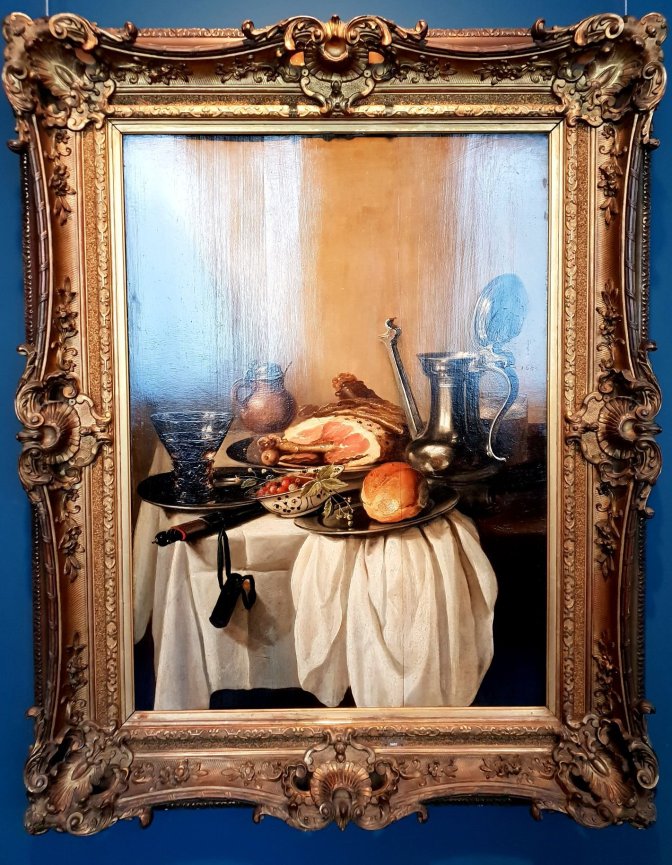
Flagon and Mysterious Tumbler Pt. II
In Jan Olis’s Triktrakspelers or Backgammon Players, we see two gentlemen playing backgammon with two observers, one standing holding a Berkemeyer glass full of wine and one sitting and smoking. On the floor are several cigarette butts and on the side table is a cloth which seems to be holding a stash of tobacco. Also on that table and not stealing the scene this time is a pewter wine flagon. And just like in Pieter Claesz’s painting, we have the re-appearance of this ordinary tumbler. The liquid in the tumbler appears to be quite darker than the liquid in the Berkemeyer. Is it a different drink or just an effect of the light? Also is it just coincidence that the glass sits next to the flagon as in the Claesz painting? Both glasses have perpendicular angles. I have searched thru hundreds of photos on Google and the closest resemblance to anything from the 17th century is a German beaker glass which lacks a stem but is often slightly flared so the opening at the top has a wider diameter than the base. And German beakers seem to always be decorated and in fact were commonly not made from glass at all. If the two depicted in these paintings have any decorations at all, they are very subtlely implied. Perhaps the fact that the gentlemen standing is drinking from the more elegant Berkemeyer while the seated smoking gentlemen appears to be drinking from a less elegant glass is some representation of their difference in status. Going back to Claesz’s painting, this could then mean that the painting represents an allegory for a person of lower esteem who is just as likely to drink wine from a common looking glass as he is to chug it directly from the flagon, ignoring the Berkemeyer glass altogether. Incidentally, Jan Olis was a registered wine merchant.

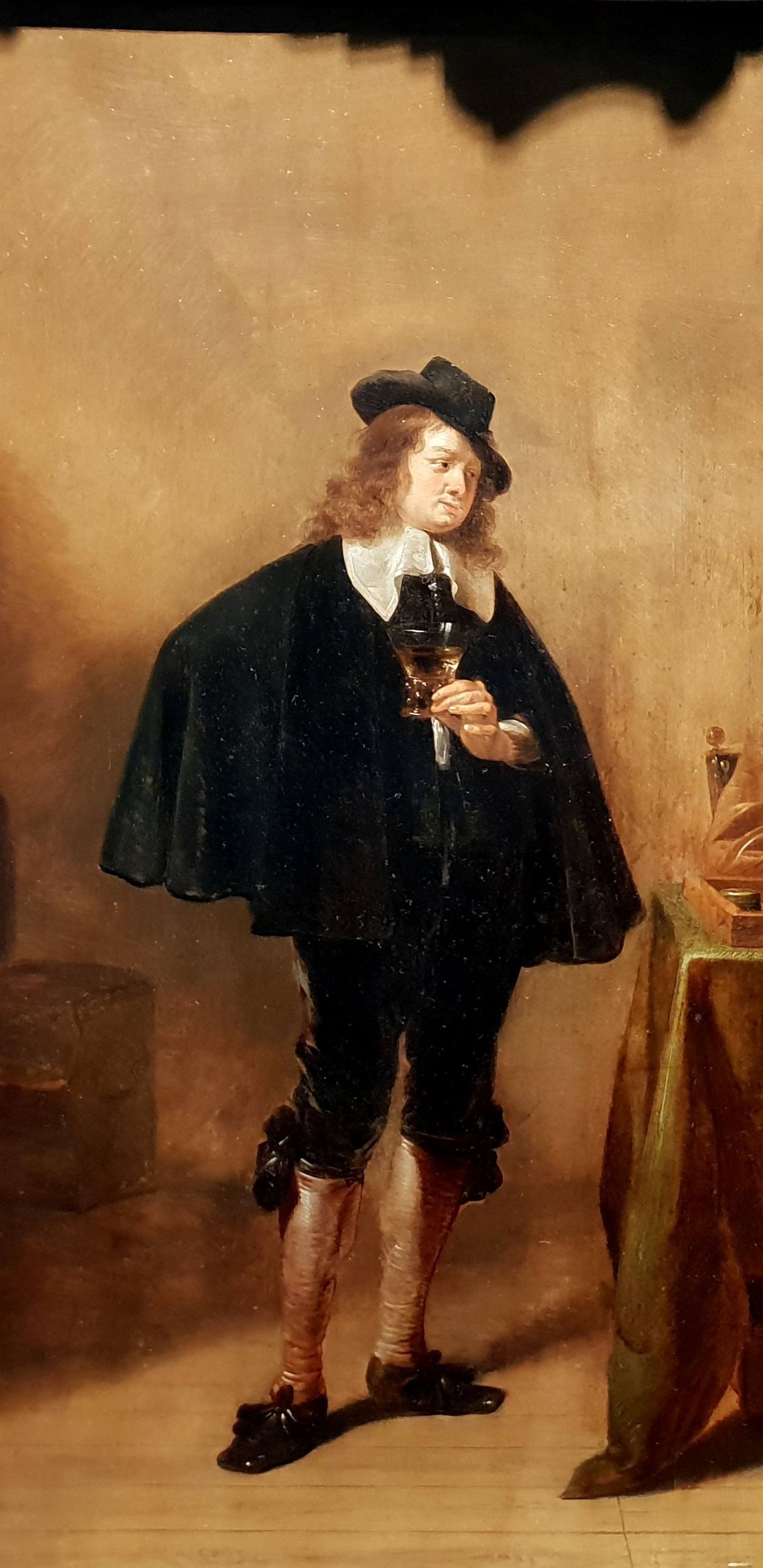

The Christ Flagon
How about a painting which depicts the biblical scene of Jesus visiting Martha and Mary but occuring in the 16th century? In Antwerp artist Joachim Beuckelaer’s painting from 1565, we see Mary and Martha getting ready for a bountiful barbecue. Meanwhile, Jesus, looking more like a close relative of the British royal family than the typical depiction of Christ, is wearing an apron and lost in thought while the charcoal is seemingly off-canvas heating up. The solemnity of his countenance is perhaps due to the large skewer which is reminding him of the sacrifice that will come. Meanwhile, nosy neighbors appear to be gawking from the courtyard.
The flagon is partially hidden behind a ham hock with four Berkemeyer glasses nearby. The pewter of this flagon shows signs of wear, the thumb lever seems to be slightly discolored from use and the body has long since lost its shine. The two rolls resemble the typical hard-shelled rolls that still exist today in Belgium, which means this country has been suffering from bad breadmaking for at least 450 years.

After a short break, the Glass Reappears
This is Jacob Jordaens’ Sater en Boer or Satyr and Traveller. There in the right hand of the barmaid, prominently displayed, is a rather plain looking glass, somewhat decorated, and full of a liquid. It is highly doubtful this is a lambic beer although the color is a spitting image of it. It must be wine. In my mind, that is definitely a German beaker glass. In her left hand is a ceramic stein with some kind of coat of arms on it.
The scene itself depicts Aesop’s fable of the Satyr and the Traveller where the Traveller is invited into the home of the satyr and proceeds to blow on his hands to warm them up and then blow on his soup to cool it down. Confused by this apparent contradiction, the satyr then distrusts the traveller and asks him to leave. The fable is a warning about duplicity or blowing hot and cold. Perhaps this duplicity is evident in the three appearances of the so-called German beaker glass. In each case, there is also a more elegant alternative drinking vessel. The barmaid holds both, offering the traveller the stein in lieu of the clearly full beaker glass. Does the beaker represent a more crude way of drinking wine while the Berkemeyers or the heraldic stein represent the more sophisticated way? Is this duplicity an allegory of how we attempt to show ourselves as being a certain type of person (cultured) but then behind the scenes, we are really another (uncouth)? Is this the meaning of the partially hidden glass in Claesz’s painting, the less prominent glass on the side table next to the smoker in Olis’s painting, and how the glass is held behind the traveller out of his view by the barmaid? Maybe I am blowing hot and cold air like the traveller, but I feel like we are getting somewhere!

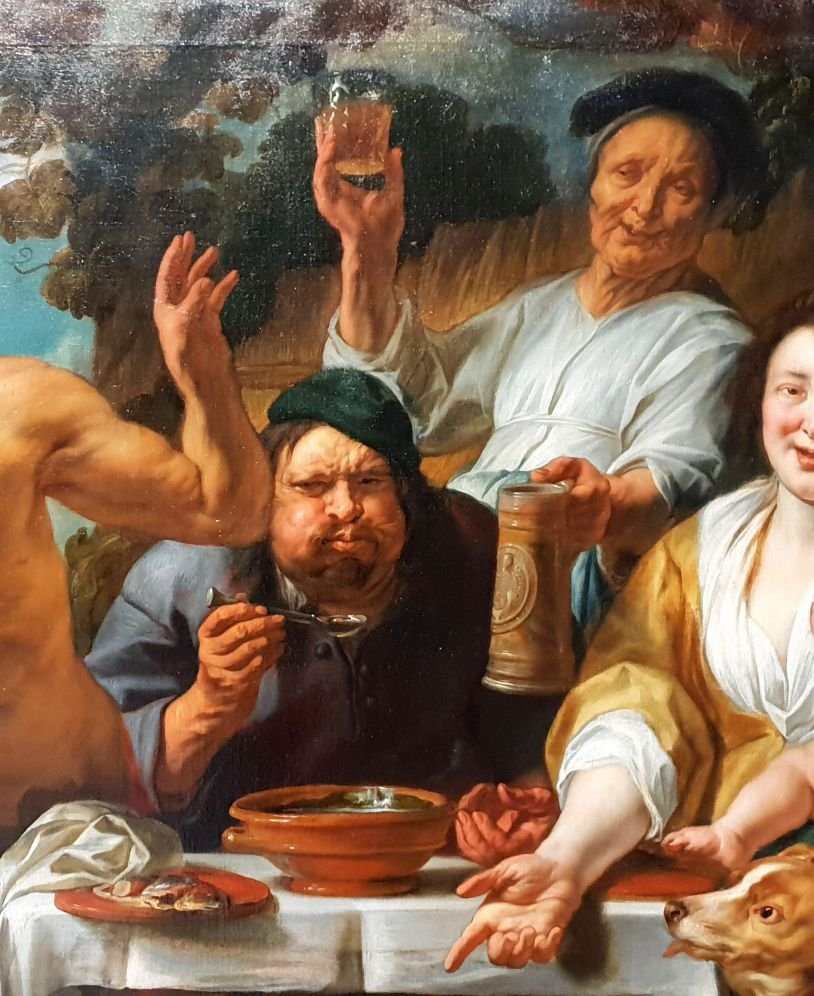
Then again, maybe the barmaid is about to hand the less elegant glass to the Satyr, who is the host, while giving the nicer stein to the traveller as a gesture of hospitality. Which brings me to the next Drunken Masterpiece.
There Be Flagons…Not
There is so much about this next painting that I love. Here we have Gabriël Metsu’s Galant Gezelschap or Courteous Company. No date, but Metsu lived from 1629-1667. Like the Traveller in the previous painting, the woman in the foreground, with the humble but rich-looking white and burgundy dress, is a guest in someone’s home. She is holding neither a Berkemeyer nor beaker glass, but a fluted type of wine glass looking like an ancestor of today’s champagne glasses. The master of the house is offering her more to drink from a ceramic flask with a metallic lid. The gesture of the woman is one of Hey, slow down, Mister. Her angelic gaze framed by a pious head covering is not directed at the man, but right thru him, perhaps towards the lady of the house who is bringing in some food. You can just imagine the munchies coming on as she is feeling the buzz from drinking the first half of her glass. The look of the man is one of amusement as if pleased with himself for getting the dainty-looking guest drunk. The way he holds his hat with the pinky finger in a prone position is just one of the many impressive details about this painting. But nothing tops the object on the left center of the scene. If you thought the Belgian waffle with powdered sugar was a modern touristy tradition, think again.
And if you wonder if you have seen something similar to this painting from my other Drunken Masterpiece posts, then you have an amazing memory. This painting is reminiscent of Jan Vermeer’s Glass of Wine in Berlin’s Gemäldegalerie.
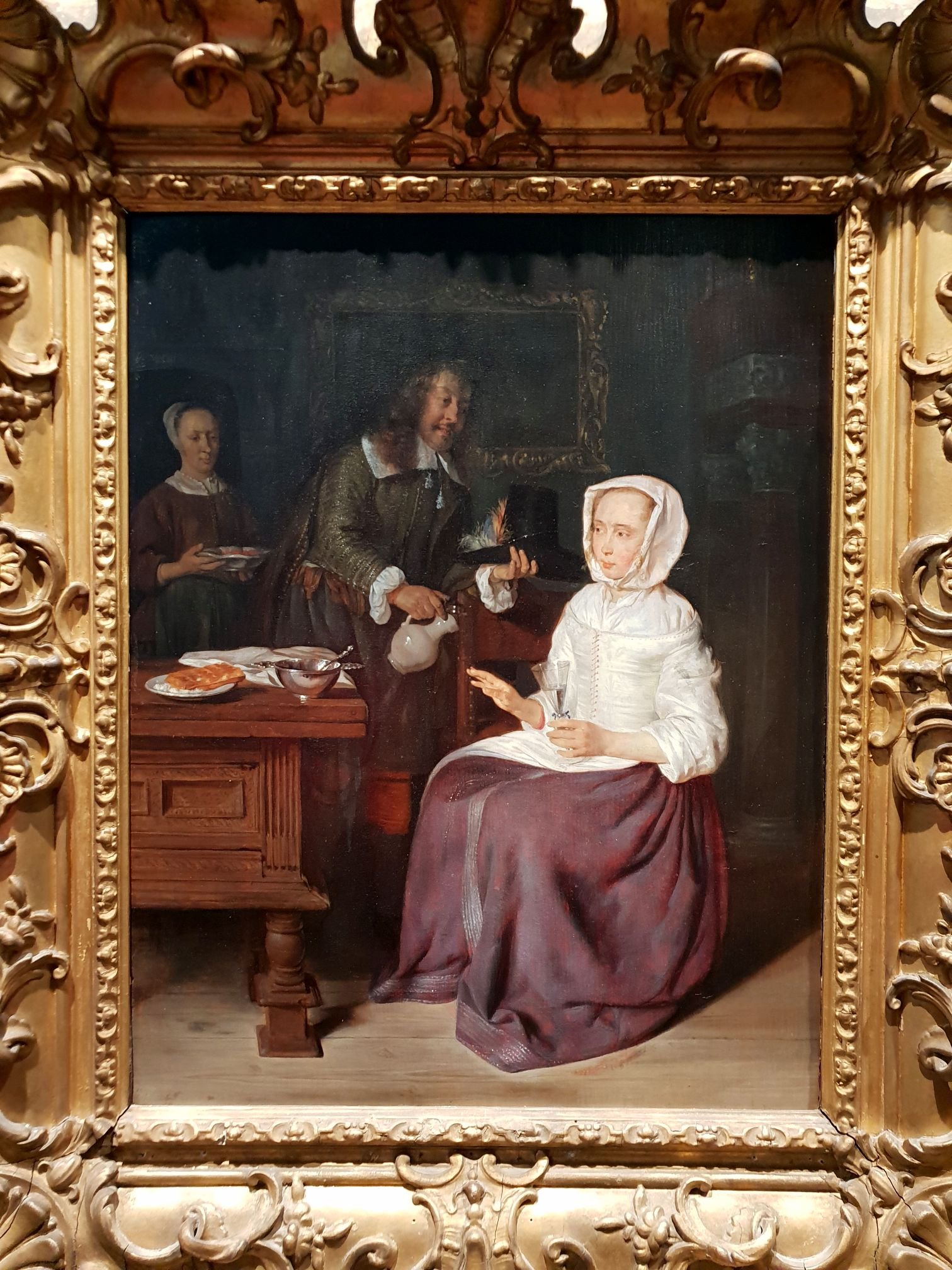

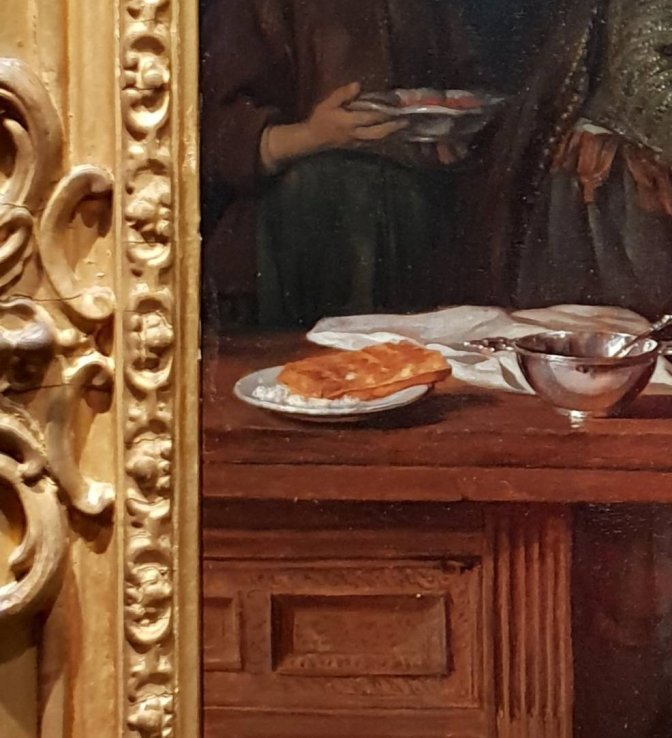
The Return of the Flagon (or the obligatory Jan Steen feature)
I may sound like a broken record by saying this, but what would a Drunken Masterpieces post be without Jan Steen? When I started this post, even the theme of this post, I assumed Jan Steen would play a role. But it was only after being halfway done with this post that I realized that not only would I feature a Jan Steen painting, but practically the entire post has Jan Steen’s stamp all over it. Hold that thought.
Jan Steen’s Het minneaanbod or The Love Proposal is a painting full of amusement and symbolism. The seated man looks like he is fumbling with an engagement ring as he is in the process of proposing to the woman seated in front of him. Speaking of duplicity, this woman is completely riddled with it. She is quite buxom but with a homely unattractive face. One breast is partially revealed and the other not. Her hand is directed toward the suitor as if to accept his proposal, but her gaze is towards the goofy patron on the right who is holding a herring and two green onions. Her outfit consists of both lush red and drab brown.
The herring in Dutch art is symbolic of the male genitals. You can imagine what gripping two green onions might symbolize. On the table is a bowl of walnuts. Some of them are opened on the plate next to it. There is a bowl on the floor with broken shell pieces and several are also scattered on the floor. I do not pretend to be an art expert but given the already symbolic duplicity of the woman, I would guess that the walnuts indicate the woman’s previous promiscuous behaviour. Meanwhile, the fool is now teasing the woman that she will now be limited to her fiance’s genitals but will also have him by the green onions.
The look on the face of the man in the background is priceless and seems more out of a Gary Larson Far Side comic than a 17th century Dutch masterpiece. And there in the left hand of the bar maid is our beloved flagon. Where is the barmaid about to pour the wine from the flagon? Into the walnuts? If the flagon’s erect spout and walnuts isn’t phallic in nature, then I don’t know what is. Jan Steen knew what he was doing.


Speaking of flagons and Jan Steen.
Google Jan Steen kan. I dare you.
Final Words
(Pausing for you to search) Well, that was a pretty cool coincidence, huh? I had no idea when I started writing this post just how much Jan Steen was influencing it. The Brussels Old Masters Museum is rich with other great Drunken Masterpieces, enough for multiple posts and I would recommend not overlooking it when visiting Brussels (like I did for almost 10 years). Traditionally when I publish a new post, you will find me soon after celebrating with a beer down at my local pub. I suppose I will ponder whether I am the type of person that would drink from a Berkemeyer, a German beaker tumbler thingy, or straight from the Jan Steen kan. Or even better, from a ceramic stein. I must admit that I am pretty particular about what I drink from. Belgian beer culture pretty much insists on that. But when I am sipping quietly on my celebratory Belgian tripel, what I really am imagining doing is this…





Oh, no Rembrandts and Rubens? 😁
I love how you describe every detail, it’s like you are in the painting, back in time.
The painting with the Belgian waffle, in that time? 😮
It was really a pleasure to read your post. Thank you Matthew! 😉👏👏
LikeLike
Your posts are always about more than hiking. But I digress. Please know that my mother had a number of ceramic steins that she doled out to her children prior to her death (I assume her father gave them to her, but my sister, Maryann, might know for sure). And the one I have, I now know I want you to have eventually No hurry. But it’s here. Your grandfather loved the Old Masters (he was an art and antiques dealer for the last two decades of his life). And the Jacob Jordaens painting that you feature in your closing passage explains why: It’s hilarious. And so was he.
LikeLiked by 1 person
Thanks Dad! I would love to have that stein. I have a few which I have picked up in my travels to supplement my beer glass collection. I wish I had had the opportunity to listen to my grandfather talk about art.
LikeLike
I did google Jan Steen kan, thank you for pausing. 😊 This is a wonderful trip through the Old Masters Museum. You share art with as much care and enthusiasm as you do beautiful hikes and spectacular beer. I imagine that Oktoberfest is very much in your thoughts just now but I did enjoy this adventure! 😊
LikeLiked by 1 person
Thank you and to be honest I enjoy writing these posts more than writing about the hikes but I do more hikes than art museums 😂 No Oktoberfest has definitely occupied my mind these last few weeks… 😢😁
LikeLiked by 1 person
I look forward to your art posts very much. 😊 For several years I did art history with 8-12 year olds once or twice a week. We didn’t cover drunken masterpieces..😉. Nevertheless, it was a joy to me and I miss it very much. Here’s hoping Oktoberfest will be twice as grand next year! ☺️☺️
LikeLike